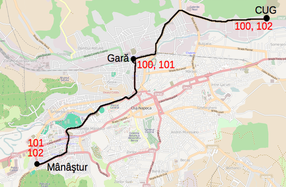Cluj-Napoca tram
| Cluj-Napoca tram | |
|---|---|
| The first PESA Swing in Cluj on Strada Plopilor on June 7th, 2012 | |
| Basic information | |
| Country | Romania |
| city | Cluj-Napoca |
| opening | August 28, 1893 |
| electrification | 1st October 1987 |
| operator | CTP |
| Infrastructure | |
| Route length | 11.7 km |
| Gauge | 1435 mm ( standard gauge ) |
| Power system | 750 volt DC overhead line |
| Stops | 19th |
| Depots | 1 |
| business | |
| Lines | 3 |
| vehicles | 4 PESA 120Na C, 24 Tatra KT4D , 10 KT4DM |
| Network plan | |
The Cluj-Napoca tram is the tram system in the city of Cluj-Napoca (German: Klausenburg) in Transylvania , Romania . It has been in service since 1987 and is the successor to a steam tram that ceased operations in 1902. There are three lines operated by CTP that run on the 11.7-kilometer standard-gauge line . Modern low-floor trams have also been in use since 2012 .
history
Steam tram
In May 1892 the construction of a steam tram between the city center and the train station began in what was then Kolozsvár. Operations began on August 28, 1893. In 1894 more than 400,000 people were carried on three lines. In 1898 and 1899 the idea of electrifying the tram line came up. However, since the city council only accepted a power rail and no overhead line for power transmission, this plan was not implemented because of the costs. On May 15, 1902, the steam tram was discontinued.
Electric tram
It was not until the end of the 20th century that the idea of an electric tram was realized in Cluj. The first section of the 11.7-kilometer line went into operation on October 1, 1987. It started at the train station and led to the mechanical engineering combine CUG. A second section was opened on November 10, 1987. A planned third section to the Gheorgheni settlement has not yet been implemented.
Lines
Currently run in Cluj-Napoca three lines, only the line 102 is traveling as a diameter line the entire route. The radial lines 100 and 101 complement these and each travel a section starting at the station.
| line | Line route | length | Hold |
|---|---|---|---|
| 100 | CUG ↔ Piaṭa Gârii | 5.8 km | 9 |
| 101 | Mânâştur ↔ Piaṭa Gârii | 6 km | 11 |
| 102 | Mânâştur ↔ Piaṭa Gârii ↔ CUG | 11.7 km | 19th |
vehicles
The Cluj-Napoca tram was opened with local vehicles of the types V2A and V3A as well as Timiș 2 . While the first two series were shut down quite early, in June 2011 the last of the original 39 Timiș 2 large-capacity trains also went out of service, it is intended as a museum car. Cluj-Napoca was the last city in which these were used as planned. The Romanian-made cars were replaced between 1997 and 1999 by 26 used Tatra KT4D multiple units of the Berlin tram . Other used vehicles were 18 Tatra T4D cars , which were taken over by the Magdeburg tram in 2002 . From January 2009 modernized Tatra KT4DM were delivered from Potsdam .
On December 23, 2011, a preliminary contract was signed with the Polish company PESA for the delivery of 12 swing- type low-floor trams . The Romanian competitor Astra Vagoane Călători appealed against the award. The national public procurement tribunal found the complaint to be well founded. However, PESA appealed this decision and on March 22, 2012 the appellate court ruled that the award to the company PESA was permissible. The contract was signed on March 28, 2012 and the first vehicle with car number 81 was in Cluj at the end of May 2012 before the reopened western half of the route. The second swing, number 82, arrived at the beginning of June.
In November 2013, Cluj-Napoca had a total of 38 trams:
- 4 PESA 120NaC
- 24 Tatra KT4D
- 10 Tatra KT4DM
Web links
Individual evidence
- ^ Polish trams will run in Romania. (Polish)
- ↑ First swing in May in Romania (Polish)



